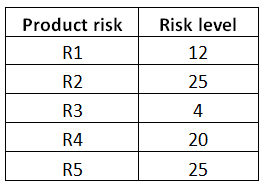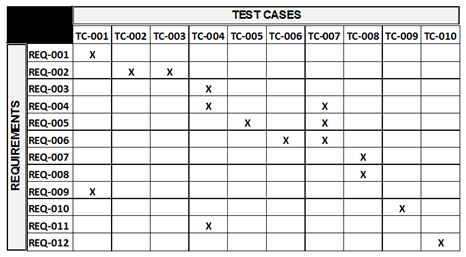iSQI CTAL-TM_Syll2012 - ISTQB® Certified Tester Advanced Level - Test Manager [Syllabus 2012]
The following are the requirements identified as “criticalâ€:
REQ-SEL-001. The user shall be able to combine all the three products with all the four durations to define an item to purchase
REQ-SEL-002. The user shall be able to add a maximum of six different items to the shopping cart
REQ-PUR-001. The user shall be able to purchase all the items in the shopping cart using a credit voucher
REQ-PUR-002. The user shall be able to purchase all the items in the shopping cart using the available credit already charged on the smartcard
REQ-PUR-003. The user shall be able to purchase all the items in the shopping cart using all the accepted credit cards (Visa, MasterCard and Great Wall Card)
REG-LOGO-001. The user shall be able to logout (by clicking the logout button) from both the “select†and “purchase†pages going back to the “browse†page (anonymous navigation)
Moreover the following quality risk item has been identified as “criticalâ€:
QR-P1. The web customer portal might not be able to provide the expected response time (less than 10 sec) for the purchase transactions under a load of up-to 1000 concurrent users
Test analysis for system testing has just begun and the following test conditions have been identified:
TC-SEL-01. Test the combinations of products and durations to define an item to purchase
TC-SEL-02. Test the maximum number of items, which can be added to the shopping cart
TC-PUR-01. Test the purchase of an item
TC-PUR-02. Test the purchase of an item with the credit charged on the smartcard
What is the MINIMUM number of test conditions that must be added to fulfill both the EXCR1 and EXCR2 exit criteria?
Number of correct responses: 1
K32 credits
Testing Process
The following are the exit criteria described in the test plan of a software product:
EX1. The test suite for the product must ensure that at least each quality risk item is covered by at least one test case (a quality risk item can be covered by more test cases).
EX2. All test cases in the test suite must be run during the execution phase.
EX3. Defects are classified into two categories: “C†(critical defect) and “NC†(non-critical defect). No known C defects shall exist in the product at the end of the test execution phase.
Which of the following information is useless when the specified exit criteria is evaluated?
Number of correct responses: 1
K21 credit
Assume that no additional product risks have been identified during the first week of test execution.


Which of the following answers would you expect to best describe the residual risks associated with the identified product risks, at the end of the first week of test execution?
Number of correct responses: 1
K32 credits
Assume that the following test cases have been executed at the end of the first week of test execution: TC-001, TC-002 and TC-007. All these tests are ‘passes’.
What is the MINIMUM number of the remaining test cases that must be successfully executed to fulfill the EX1 exit criteria?

Number of correct responses: 1
K32 credits
The following is the unique “critical†quality risk item that has been identified:
CR-RSK-1. The GUI of the application might accept non-integer values for the input field designed to get the number of bottles from the user
Test analysis for system testing has just begun and the following test conditions have been identified:
TC-SEL-2. Test the selection of the package sizes
TC-SEL-4. Test wrong numbers of bottles for an order
TC-CR-RSK-1. Test the accepted values from the input field designed to get the number of bottles from the user
Assume that you have used traceability to determine the logical test cases that cover all the requirements and the single risk item identified in that scenario.
Which of the following is a positive logical test that is complete and correct, and covers the REQ-SEL-4 requirement?
Number of correct responses: 1
K32 credits
Test Management
Which of the following answers describes a factor that may reduce the effort spent when using distributed test teams without negatively affecting system quality?
Number of correct responses: 1
K21 credit
Test Management
Assume you are currently working on a project developing a system where functional requirements are very well specified. Unfortunately non-functional requirements do almost not exist.
You are the Test Manager. You have to choose a technique for test selection that allows testing of non-functional characteristics, especially reliability.
Which of the following techniques for test selection do you expect being most useful in this scenario?
Number of correct responses: 1
K21 credit
Test Management
You are the Test Manager on a project following an iterative life-cycle model. The project should consist of nine iterations of one month duration each. It is planned to develop the most important features to have a stable core of the application in the first three iterations and to add the additional features in the last six iterations.
At the beginning of the first iteration, only a draft version of the requirements specification document for the core features is available. Assume that during each of the first three iterations, the chosen features are fully completed and unit tested.
Which of the following statements is true in this context?
Number of correct responses: 1
K43 credits
Test Management
In the test strategy document your organization declares:
- to adopt a V-model development lifecycle, with three formal levels of testing: unit, integration and system testing
- to use a blended risk-based and regression-averse testing strategy for each level of testing
The following is an excerpt of the “approach†section for the system test plan document of a new project:
“Testing will only use manual tests. Due to the short period of time for test execution, the following activities will be performed in parallel with test execution: Test planning, test analysis and test design.
Basic metrics will be taken for test effort (i.e. person-hours), test cases executed (passed/failed), and incidents (no more metrics, such as code coverage, will be collected).â€
In the system test plan, no deviations from the test strategy are described.
Based only on the given information, which of the following statements is true?
Number of correct responses: 1
K43 credits
Test Management
You are working on a project to develop an authentication system for an e-commerce website. This system provides two features: Registration and authentication. Two different development teams develop these two features.
There is a high likelihood that the delivery of the authentication feature to the test team will be three weeks later. To complete the registration the user must provide the following registration inputs: Name, surname, birthdate, fiscal code and he/she can select a username and a password.
A registered user can be a special user or a normal user. To be identified as a special user, he/she must also provide, during the registration process, a voucher possibly received from the IT department.
Access is granted only if a user is registered and the password is correct: In all other cases access is denied. If the registered user is a special user and the password is wrong, a special warning is shown on the system console.
You are currently performing a quality risk analysis using FMEA.
Based only on the given information, which of the following is NOT a product risk that could be identified during the quality risk analysis?
Number of correct responses: 1
K43 credits



